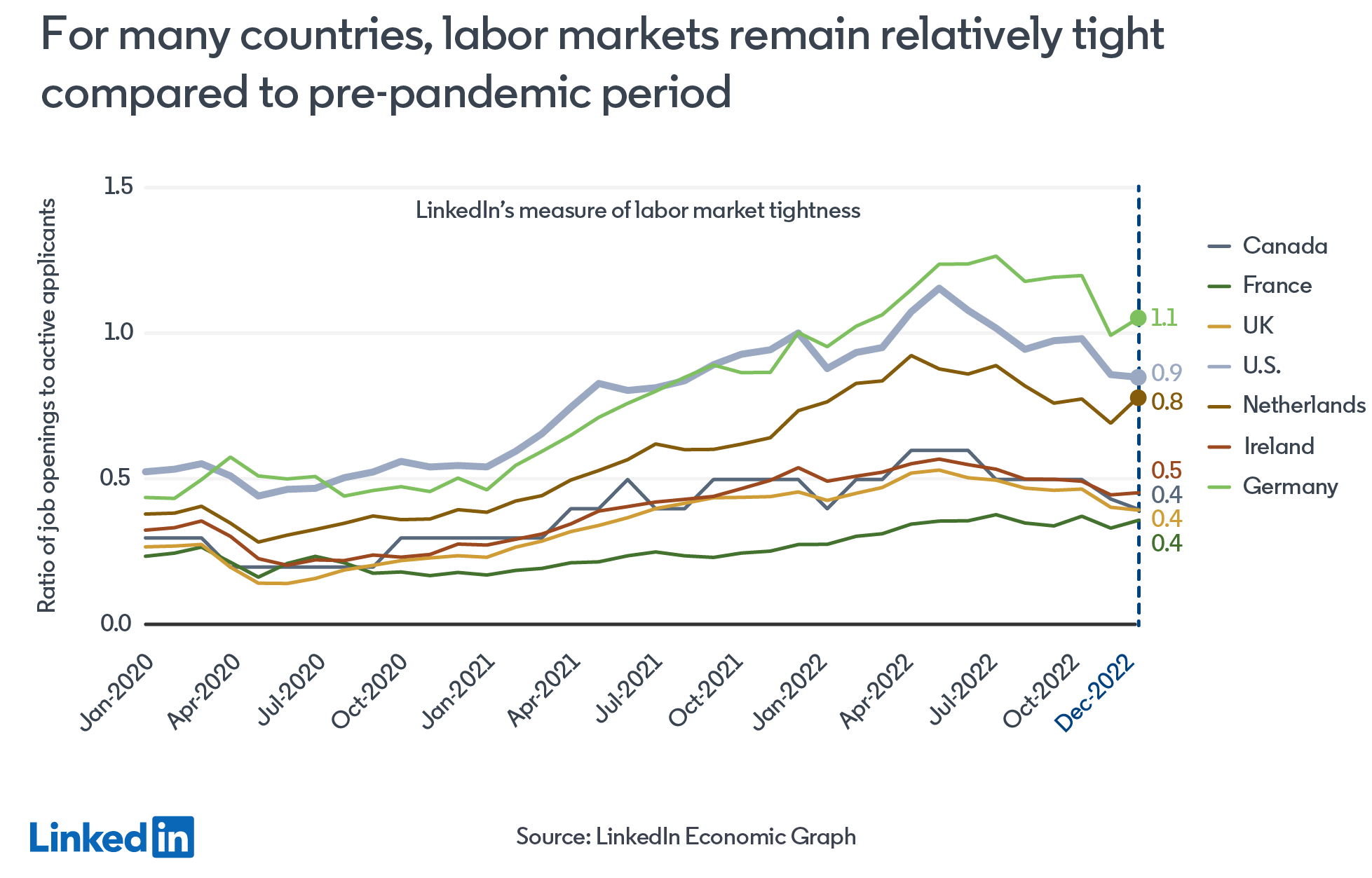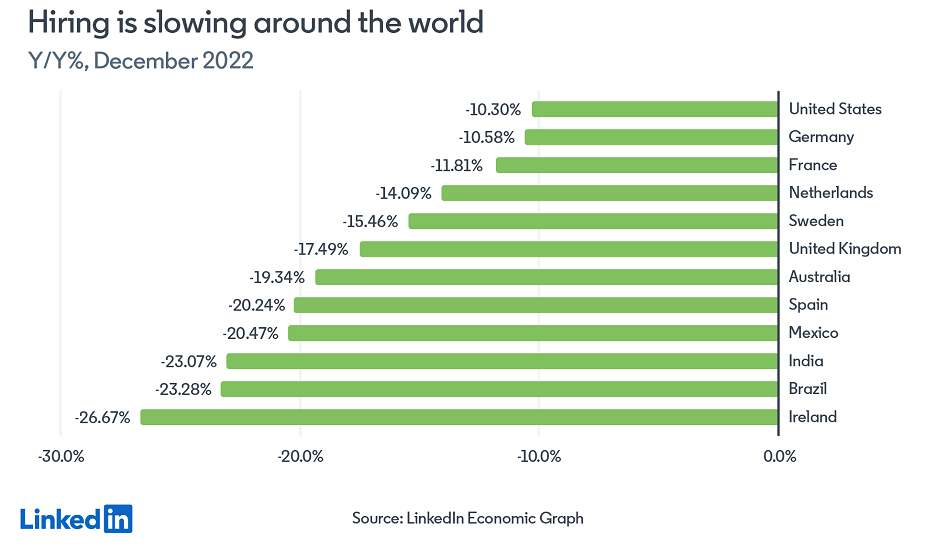
The outlook for 2023 is uncertain, but here’s what we know about the global labour market
This blog was originally published on the World Economic Forum.
Data shows hiring is slowing down globally amidst economic uncertainty and the balance of power has tipped slightly back towards employers, but labour markets are still relatively tight compared to before the COVID-19 pandemic.
Sustainability, cyber security and sales roles are among the fastest-growing jobs and offer some of the strongest opportunities for job seekers.
Equipping the workforce of the future with universal access to better education, jobs and skills will ensure we are in a better position to weather economic headwinds through 2023 and beyond.
While much has changed in the past 12 months, one constant is that the global labour market is tight - even by historic standards - and this trend looks set to continue through 2023.
At LinkedIn, we determine labour market tightness by looking at the ratio of open jobs to applicants on our platform, which is made up of more than 875 million members across the world. Our data shows that global labour markets are still tight compared to before the COVID-19 pandemic, meaning that while the next 12 months look more challenging, there are opportunities for those looking to make a career move. On average, we’re not seeing really strong competition for roles that you might expect amidst a more challenging economic outlook. There are two active applicants for every open role in the UK and France, for example, and one active job opening for every active applicant in Germany and the US.

While an economic slowdown across many areas of the world is predicted to continue during 2023, we can take heart that when it comes to the global labour market this slowdown doesn’t look like it will be nearly as severe as what we saw in 2020 or 2009. While hiring is likely to continue to slow, it’s coming down from record highs and the slowdown in output growth in 2023 is not generally expected to be reflected in large rises in unemployment.
In terms of real-world application, while the balance of power has tipped slightly towards employers, companies still need to work hard to attract and retain talent, powering some strong opportunities for job seekers. According to insights from LinkedIn’s Global Talent Trends, employees still highly value work-life balance, flexible work arrangements and upskilling, three priorities that surfaced as a result of the COVID-19 pandemic. While companies in 2023 may be trying to do more with less, businesses must turn their focus inwards and listen to the drivers that are important to their employees, while encouraging a company culture with policies and frameworks that embody career flexibility and mobility at the core.

Jobs on the Rise for 2023
For people looking to make a career change in 2023, what roles are companies competing to fill? Our data reveals that immediate global challenges posed by climate change, cyber threats and the need to drive business growth are creating job opportunities for job seekers.
Looking back, 2022 was a big year for the climate agenda with the annual United Nations Climate Change Conference (COP 27) held in Egypt, marking 30 years since the Framework Convention (UNFCCC) was instilled and seven years since the Paris Agreement was agreed at COP21. The good news is that the urgent need for action to tackle the climate emergency is driving a noticeable rise in the number of green jobs.
As companies are increasingly grappling with the need to boost sustainability, our insights show that sustainability roles are in demand in 13 countries, ranging from Australia, Brazil, France, Germany, India, Saudi Arabia, the UK and US. While this is encouraging, we’ve still got a long way to go. We must go further and faster to reach climate change targets.
In parallel, another challenge facing companies across the globe is the omnipresent cyber security threat. The FBI’s most recent annual Internet Crime Report estimates that cybercrime costs the US economy around $6.9 billion. Not surprisingly, we’re seeing companies bolstering their defences, with cybersecurity roles featuring in the list of LinkedIn’s Jobs on the Rise for 18 countries, including Canada, Germany, Brazil, Egypt and Singapore.
The third trend we see is that companies are still looking to drive growth - prompting a surge in demand for sales and business development roles. Our insights show that companies across the world are honing in on talent throughout the customer journey, from lead generation to customer retention.
Equal access to opportunity
While we believe that the global labour market in 2023 has some bright spots and that there are pockets of momentum, we know that not everyone has equal access to those opportunities. According to data from The World Economic Forum (WEF), by 2025, an “estimated 97 million new jobs will emerge and 85 million others will be displaced by a shift in the division of labour between humans and machines.”
What’s clear to me is the fundamental need to identify and invest in the jobs of the future, while equipping people with the skills and support needed to transition into them. It's mission-critical that we do more to break down systemic barriers and ensure that opportunities, skills and education are equally distributed. LinkedIn has made a number of resources available to help people learn the skills for jobs that are growing and in-demand
I’m also proud to support two WEF initiatives that are laser-focused on addressing the opportunity imbalance. The first, The Jobs Consortium, is a coalition of CEOs and Ministers with a common vision for a better future of work for all. They promote boosting foresight on labour market trends, identifying investments in key sectors leading to good job creation and high job quality, fair wages and dynamic job transitions.
The second, WEF’s Reskilling Revolution, aims to help 1 billion people over the next ten years to contribute to future-proofing countries, companies and livelihoods. The ambitious programme prepares the global workforce with the skills needed to transition their careers to new and emerging jobs as technologies, such as artificial intelligence, enable greater automation.
Pulling all these threads together, ensuring there is a robust global talent pipeline by equipping the workforce of the future with the right skills to transition into emerging jobs is imperative if we are to provide universal access to opportunity. While the outlook for 2023 is uncertain, planning for the future will ensure we are in a better position to weather economic headwinds, while democratising equal access to job opportunities for the global workforce as we move through 2023 and beyond.
